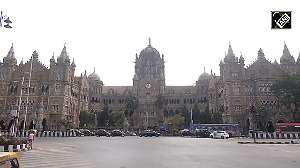The devastating earthquake which struck Pakistan and Pakistan-occupied Kashmir was a direct result of the Indian sub-continent's shift towards the north and its collision with the Eurasian continent, the United States Geological survey said on Sunday.
"Earthquakes and active faults in northern Pakistan and adjacent parts of India and Afghanistan were the direct result of the Indian subcontinent moving northward at a rate of about 40 mm per year and colliding with the Eurasian continent," USGS said in its report on Saturday's quake which killed many people in Pakistan and Jammu and Kashmir.
Complete Coverage: Terror from the earth
This collision is causing upliftment that produces the highest mountain peaks in the world, including the Himalayan, Karakoram, Pamir and Hindu Kush ranges.
As the Indian plate moves northward, it is being pushed beneath the Eurasian plate, the USGS said.
Much of the compressional motion between these two colliding plates has been and continues to be accommodated by a slip on a suite of major thrust faults that are at the earth's surface in the foothills of the mountains and dip northward beneath the ranges, it said.
"These thrust faults have a sinuous trace as they arc across the foothills in northern India and into northern Pakistan," Pakistan's APP news agency quoted USGS as saying.
Near the town of Muzaffarabad, the Capital of Pakistan-occupied Kashmir, about 10 km southwest of the quake's epicentre, active thrust faults that strike northwest-southeast have deformed and warped Pleistocene alluvial-fan surfaces into anticlinal ridges.
Complete Coverage: Terror from the earth







 © 2025
© 2025